Among the walls of the Rocca di Vignola, there is a chapel full of charm and filled with symbolic references, which allows us to take a journey through centuries of history: it is the Contrari Chapel, whose events probably began in the third decade of the 15th century, when the lord of Vignola, Uguccione Contrari, feudatory of Niccolò III d’Este, decided to have the castle’s room destined for recollection and prayer frescoed. The work is by an artist whose identity is currently unknown: a number of names have been proposed by art historians who have labored in attempts at attribution (ranging from Belbello da Pavia to Giovanni da Modena via Michele dai Carri) but, due to the fact that there are no other works that can be assigned with absolute certainty to the same hand, the author of the frescoes has always been generically known as the Master of Vignola.
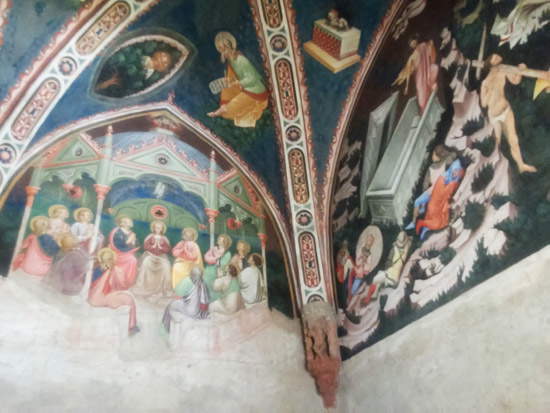 |
| View of the Contrari Chapel |
Before delving into the scenes that decorate the Chapel’s walls, let’s say that this room of the Rocca remained closed for centuries, disappearing almost completely from documents (it is only mentioned as a small church in a 1642 inventory and as a small chapel a couple of centuries later) and consequently going into oblivion. An oblivion, however, that has helped to preserve in excellent condition the splendid cycle of frescoes that decorates the walls of the Contrari Chapel: thanks to two restoration interventions, the first conducted between 1991 and 1992, and the second conducted between 2005 and 2006, the frescoes have been cleaned, restored of adhesion defects, and properly reintegrated.
But what is the reason for this sort of censure that has affected the Contrari Chapel? It is necessary, meanwhile, to leap back as far as the 12th century to lap up the thought of Gioacchino da Fiore (c. 1130 - 1202), a Calabrian theologian and mystic whose theories often encountered, throughout history, vivid resistance from the official Church: suffice it to say that the cause of beatification has been protracted for centuries, was reopened only in 2001, and is currently at a standstill. The cycle is pregnant with references to the thought of Joachim of Fiore, so much so that we could call it a Joachimite cycle, and before long we will see why. But the reasons why the Vignola cycle has long been forgotten must also be sought elsewhere: the texts from which the depicted episodes mainly draw, in fact, are not the four canonical Gospels, that is, those officially recognized by the Church since the Council of Trent. The episodes were mainly inspired by the apocryphal texts, the books that are definitively expunged from the Church’s official Canon precisely with the Council of Trent, which, let us remember, was held between 1545 and 1563: if until then the apocrypha could also be accepted as a source of inspiration for the depiction of the works of Jesus, from that moment on they were considered contrary toCatholic orthodoxy. And, as if that were not enough, the chapel is also full of symbolic references that the Council of Trent definitively banned: some of these iconographies, were even considered heretical.
In reality, for 15th-century religiosity there was nothing heretical about them: these are frescoes produced at a time when the Christian religion knew different forms, traditions, symbols and customs than those that would be strictly established about a century and a half later. The journey inside the frescoes can begin right from the vault of the chapel, where we find the figures of the four evangelists. We can easily notice that the evangelists are not accompanied, as we would expect, by their traditional symbols: the lion for St. Mark, the eagle for St. John, the ox for St. Luke, and the angel for St. Matthew. We can recognize the evangelists only if we are aware of the contents of their Gospels: each of the evangelists is in fact portrayed in the act of penning a book with a sentence in Gothic script taken from their respective Gospels, and is accompanied by a figure referring to their contents. And here we already realize an incontrovertible fact: the frescoes were intended for a culturally highly refined environment that was deeply familiar with the sacred texts.
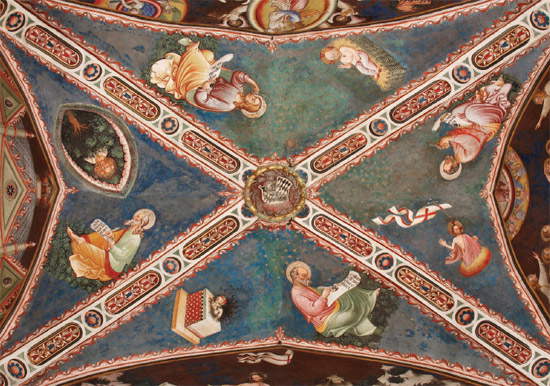 |
| Vault of the Contrari Chapel, with the evangelists and their symbols. © Rocca di Vignola Foundation |
The sail above the entrance wall depicts Saint John writing the beginning of his Gospel(In principio erat Verbum, “In the beginning was the Word”), and he is accompanied by a tree on which we notice a three-headed figure. The episode associated with him on the wall is that of Pentecost. Let us return for a moment to the thought of Joachim of Fiore: according to the Calabrian theologian, the history of the world should be divided into three ages. The first, the age of the Father, is the one related to the Old Testament. The second, that of the Son, is the one during which Jesus revealed himself and the Church spread his message. Finally, the third is that of the Holy Spirit: an age of grace, righteousness and freedom, during which humanity can await without fear the new coming of Christ and the final judgment. This is also why Joachimite thought was often opposed: because he believed that the age of perfection, that of the Holy Spirit, would come in the future, and consequently the Roman Church of the second age would be far from perfect. That is, it would have been a kind of project in fieri, in the process of evolution: a rigid and dogmatic Church versus the free, mystical and spiritual Church of the age of the Holy Spirit.
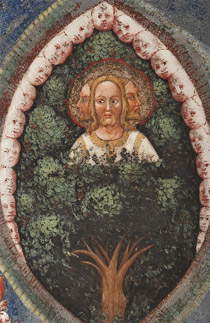 |
| The tri-frontal Trinity. © Rocca di Vignola Foundation |
We said that the sail of St. John corresponds to the episode of Pentecost: it is the moment when the Holy Spirit descends on Mary and the apostles in the form of a dove and strikes each of them in the guise of a tongue of fire, enabling them to speak all the languages of the world. The metaphor marks the beginning of the preaching of Jesus’ message to all nations. Thus we can understand why the Pentecost scene is so important: it is nothing less than a kind of hymn to the Holy Spirit.
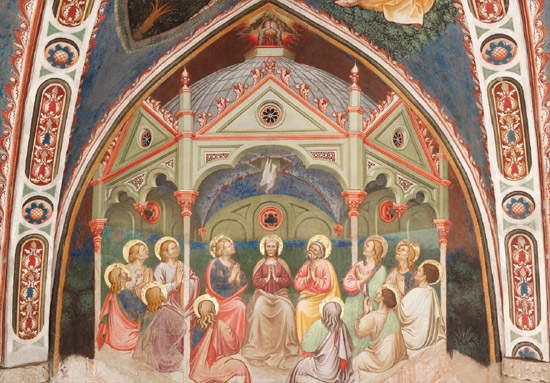 |
| Pentecost. © Rocca di Vignola Foundation |
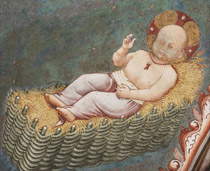 |
| Baby Jesus. © Rocca di Vignola Foundation. |
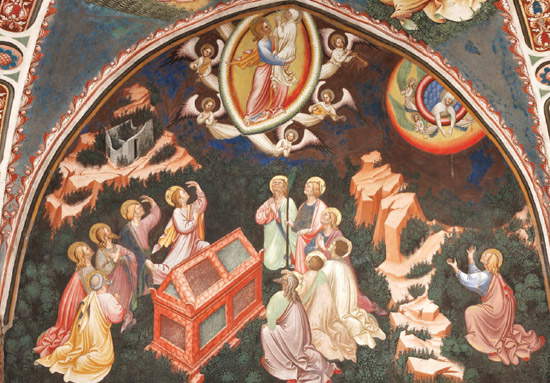 |
| The Assumption of the Virgin. © Rocca di Vignola Foundation |
 |
| Jesus takes Mary to heaven. © Rocca di Vignola Foundation |
A particular depiction of the Resurrection on the wall facing the entrance wall introduces us to another theme in Joachim of Fiore’s thought, that of reconciliation between Christians and Jews and the conversion of the latter before the coming of the age of the Holy Spirit. The evangelist associated with the episode is Mark, identified by the phrase Recumbentibus undecim (“[Appeared] to the eleven while they were at table,” the subject being the resurrected Christ) and the symbol of Christ with the crusading banner, itself a symbol of the Resurrection. We note that in the scene painted on the wall, in addition to Mary and the twelve apostles witnessing Jesus’ ascension to heaven, three figures in priestly garb appear on the right. The reference, in this case, is to the Gospel of Nicodemus, an apocryphal account in which it is said that on the day after Christ’s resurrection, three men, Adas, Phineas, and Haggai (a scribe, a priest, and a Levite, respectively), went to the Sanhedrin, the supreme court of Jewish justice, to testify to the vision of the risen Christ: their account would thus prompt the Jewish people to set out in search of Jesus. The willingness to seek Jesus is thus assimilated to that reconciliation mentioned just above.
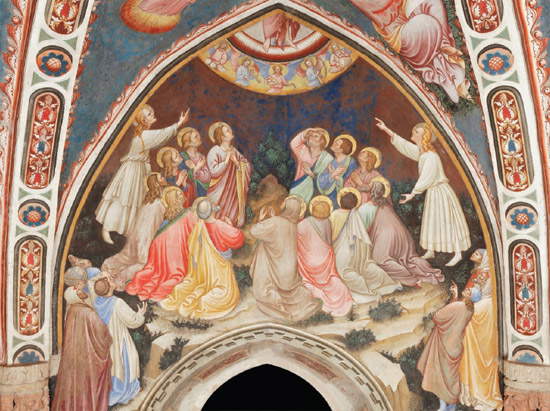 |
| Resurrection. © Rocca di Vignola Foundation |
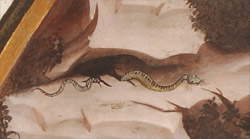 |
| The serpent of regeneration. © Rocca di Vignola Foundation. |
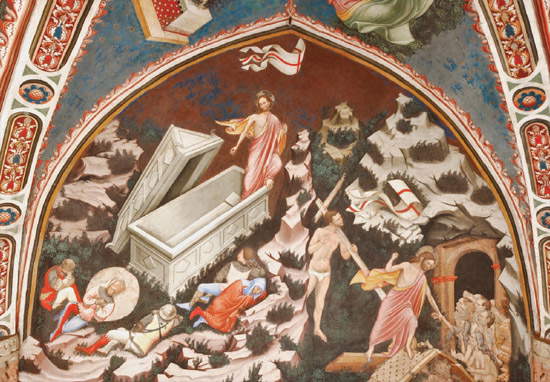 |
| Christ’s descent into hell. © Rocca di Vignola Foundation |
An iconographic program therefore not easy to read, probably suggested by an illustrious figure of the culture of the time, Donato degli Albanzani (c. 1328 - c. 1411), tutor of both Uguccione Contrari and Niccolò III d’Este (and of the latter he was also his secretary), learned humanist, pupil of Francesco Petrarch and keeper of the library of the great Tuscan poet. All the charm of the Contrari Chapel, or what was once a room reserved for a few connoisseurs of Gioacchino da Fiore’s sacred texts and theology, is now an integral part of the tour of the Rocca di Vignola. And it gives us a way to come into contact with one of the most refined environments of the time: an environment imbued with a lively and sophisticated culture, whose spirituality and hopes for the future are to be discovered by letting ourselves be guided by the power of the images of the master of Vignola, capable of effectively rendering the extraordinary complexity of these engaging frescoes, evidence of a fruitful and suggestive link between religion, mysticism, art and humanist culture.
Warning: the translation into English of the original Italian article was created using automatic tools. We undertake to review all articles, but we do not guarantee the total absence of inaccuracies in the translation due to the program. You can find the original by clicking on the ITA button. If you find any mistake,please contact us.